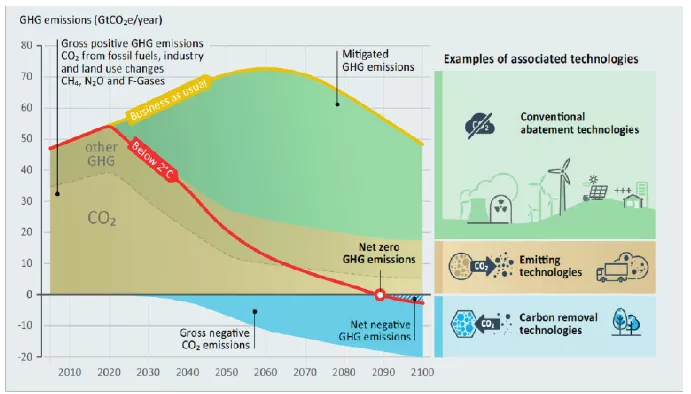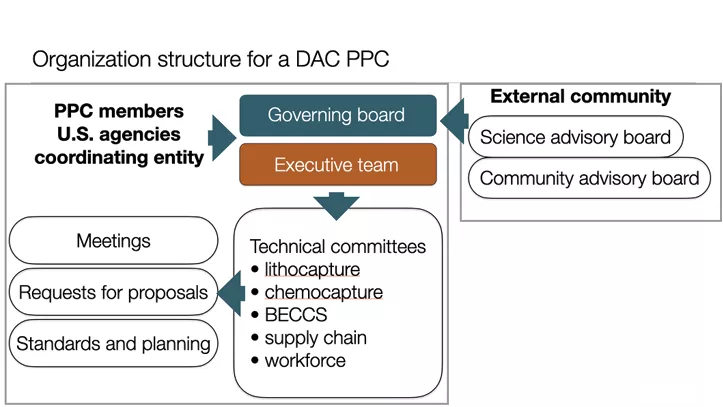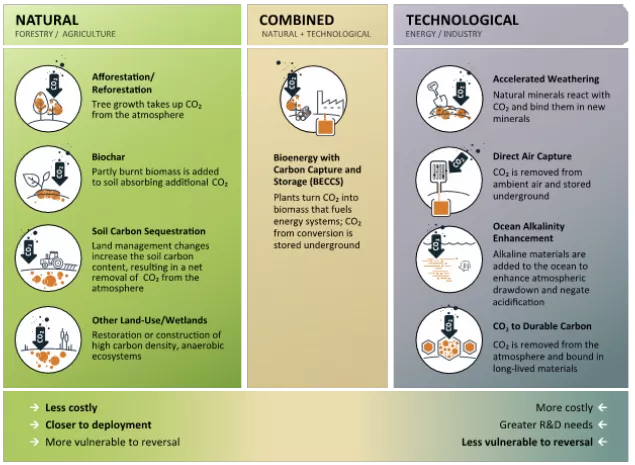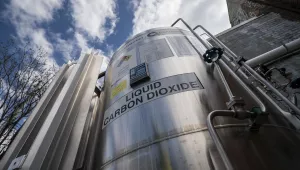
Securing a safe, livable climate for humanity requires substantial investments in technologies and policies and a comprehensive, multi-time-scale and multi-path approach. Critically, many scientific and technological areas are presently underdeveloped yet are likely to be necessary parts of the long-term sustainable future. A key example is the technology that enables the direct capture of carbon dioxide (CO2) from the air.
Direct air capture (DAC) of CO2 has high promise for large impact. Many developed and developing nations have affirmed a net-zero carbon goal by 2050 which requires both substantial changes in emissions and the use of negative emission technologies like DAC. Furthermore, DAC has an additional potential: offsetting difficult-to-transition emission sources, providing better options for a sustainable future. Still, these technologies must be deployed and scaled. The corresponding market—potentially a trillion dollars per year—will be realized by those countries that have the capability and know-how to execute carbon removal at scale. At present, a host of methods for carbon removal show promise, from use of known biological solutions in forestry and oceans to the development of novel chemical and industrial approaches. However, none have been tested at scale, nor have the technological impediments and the unanticipated developmental challenges been explored and overcome (NAS 2019).
By investing in the public and private sector research and development in this space, and by fostering a community of researchers, entrepreneurs, and investors literate in CO2 capture opportunities, the United States can be the leader of this new economic sector. It is essential for the Nation to build a vibrant and sustained research and development community spanning the public sector, academic and research domains, and for-profit companies, ensuring world leadership in this new technological domain. To bridge the divides between different sectors, I suggest a public-purpose consortium (PPC) be established to develop and implement direct air capture technologies to work toward the net-zero carbon goal. The PPC would enable early and pre-competitive research and development, working with stakeholders across the existing development spectrum and with buy-in from both key Government agencies and from other funding bodies, while ensuring that the public goals are included throughout the technology’s development. This whitepaper covers the scope, benefits, and challenges of this Direct Air Capture PPC. Its key goals are:
- Develop the science and technology for direct air capture of carbon dioxide at scale via a public-purpose consortium joining federal and private sector efforts;
- Support early adoption and market expansion opportunities;
- Focus private- and public-sector funding on shared challenges with technical leadership provided by researchers and innovators working in the space integrated with early adopter and impacted community representatives;
- Enable pilot study and testbed work via partnerships and shared intellectual property;
- Grow the workforce and the supply chain;
- Build approaches for monitoring and assessing the success of carbon capture systems to enable effective standards.
Why a Consortium?

Among various options for preventing, mitigating and adapting to climate change, direct air capture will be an essential component. In particular, even using all available emission reduction strategies, there is still a substantial need for negative emissions technology, as described in detail in the UN report (UNEP 2017), where 10 gigatons per year (Gt/y) of CO2 capture via negative emissions approaches is a minimal necessary element for keeping the earth habitable without dramatic adaption. At the same time, 10 Gt/y corresponds to a potential trillion dollar per year market by 2050, highlighting the tremendous economic opportunity direct air capture technologies offer. A more detailed investigation is available elsewhere (Larsen, Herndon, and Hiltbrand 2020).
The overall science and technology related to DAC was recently surveyed by the National Academies (NAS 2019). Their recommendations illustrate the need for a PPC. Specifically, their primary findings support the key concept that direct air capture will be a necessary part of any climate change mitigation portfolio of initiatives. Of their findings, the most important for this work is conclusion 6: “Direct air capture and carbon mineralization have high potential capacity for removing carbon, but direct air capture is currently limited by high cost and carbon mineralization by a lack of fundamental understanding.” A summary of the NAS 2019 conclusions is included in the appendix to this whitepaper.
To address the scientific and technical gaps, and, in the absence of substantive economic incentives (e.g., carbon taxes or a carbon market), to provide a supporting environment for the nascent industry interest in DAC, a cooperative effort between the public and private sectors is essential. To that end I suggest establishing a public-purpose consortium (Taylor 2020) that would enable cooperative research and development across the private sector while ensuring that knowledge gained can be leveraged by the broader scientific community. At the same time, it would help support a nascent market and early business models. It could enable federal and state-level support of efforts, from fundamental research to pilot programs to scaling investigations in a lightweight manner that amplifies and guides the direction of research, maintaining a sense of public purpose throughout the process. Finally, a consortium provides community fostering mechanisms that builds across traditional boundaries, allowing for the inclusion of equity considerations, regulatory guidance, scientific feedback, and impact assessment.
Critically, a public purpose consortium is distinct from other methods of multi-sector engagement. For example, it does not separate the risk and execution elements, as is common in public-private partnerships where the government often takes on many of the risks and private sector develops the execution in concert with, or directed by, the government. At the same time, it is also not a governmental coordinating body, as it exists first to connect members of the industrial and research communities, and only secondarily to enable those communities to coordinate with governmental efforts. Instead, it is focused on community-led, community-supported research and development while leveraging both industrial and governmental efforts.
Recent efforts to enable this type of development all point to the benefit of a coordinated public-private response, be it through the use of a foundation to complement the federal efforts or a more direct public-private partnership. A public purpose consortium devoted to DAC would develop a platform and community to implement and enable this vision.
Operating Principles
Based upon the Belfer Center policy brief on Public Purpose Consortium (Taylor 2020), I outline the basics of operation for the DAC PPC under the five key principles: build community, focus operation, show value, enable governance, and keep it nimble.
-
Community
Working from the National Academies report (NAS 2019), there are multiple communities engaged in the science and technology for direct air capture. A two-pronged approach is necessary: short-term efforts—DAC 1.0—to scale biological capture complemented with a long-term approach—DAC 2.0—for assessing industrial-scale capture using a variety of mechanism.1 However, reflecting the nascent nature of the space and the wide-open technology and innovation challenges to be addressed, the focus should be on DAC 2.0 technologies and development.
For these technologies, the key unifying element is the industrial nature of the process that enables supply chain and scaling opportunities. This also suggests that DAC 2.0 technologies may be less directly impacted by the availability of resources, such as soil and biomes appropriate for forest growth. Furthermore, for DAC 2.0 the resulting product (in forms including mineral, hydrocarbon, or compressed gas) may have additional uses in other parts of the economy that do not liberate carbon, such as in building materials. Consequently these additional product and material pathways are a key component of the PPC.
Both of these development tracks must be considered to be extensions of, and working in concert with, carbon mitigation and reduction approaches. Thus the biological capture, and other capture and reduction communities, should also be engaged in the formation, execution, and governance of the DAC PPC. Finally, while the initial focus should be on U.S.-based efforts, there is substantial benefit to considering expansion via addition of foreign members or via franchising of this approach to like-minded partners and allies.
-
Operation
The PPC focus should be on cooperative areas of research and development for DAC 2.0 pathways, while working with the interested public in ensuring that pathways for deployment and scaling account for impacted communities and regions. Additional key areas include workforce and supply chain development.
The execution of net-zero requires the whole ecosystem and marketplace working in concert. The PPC can provide means of ensuring nascent markets are considered and developed in a coordinated fashion, while leveraging private sector and government investments for a broader, shared pool of intellectual capital. A healthy research and development ecosystem around these technologies will require the PPC convene various subcommunities (see Figure 2 for specific examples) and foster cooperative research and targeted R&D that benefit stakeholders and the public good.
Critically, the PPC must focus on enabling pilot programs and developing regulatory approaches and market approaches for ensuring early carbon capture pricing and business models adhere to the fundamental public purpose of the consortium.
-
Value

Figure 2: Structure for a consortium
The PPC provides value in several areas. One is in organizing a vibrant community of parties with an interest in DAC, including enabling pre-competitive but protected conversations between competitors, and vetting of members to ensure security and intellectual capital and property concerns are appropriately shared by all members. Another is in helping to identify shared needs between competitors in areas where no market yet exists, and where competition will hurt more than help. Given the nascent state of the CO2 storage market and means of paying for CO2 direct air capture outputs, many aspects of this space remain pre-competitive; the PPC provides a key forum for such conversations. Finally, the PPC members and federal sponsors can work together to launch requests for proposals and other funding opportunities to encourage research and development work on key topics agreed upon by members that benefit the broader ecosystem.
-
Governance
A neutral body, such as a non-profit organization with high stature, can work in concert with government sponsors and key private-sector movers to build a core operating body. This platform approach would suggest a governing team led by a small executive team at the non-profit, with board members drawn from both large and small companies and U.S. agencies. Additional scientific guidance from the academic community and from the broader community working on ethical solutions to climate change mitigation would be a key part of the overall oversight structure. Relatively low dues, connected to the size of the organization involved, would support primary platform operations. At the same time, cooperative research and development opportunities can be simultaneously supported by both federal sponsors and by members of the PPC, enabling coordinated research and shared outcomes for members.
-
Lightweight
Where possible, the legal structure should be focused around enabling conversation between entities in the consortium. Government engagement via mechanisms such as other transaction authority or partnership intermediary agreements can be made efficient and effective when the time is spent on community building first. An appropriate phase-in process, such as through letters of intent and through initial planning and vetting work via meetings and convenings, can also help build additional structure, where appropriate, for the protections around intellectual property and capital developed through the consortium efforts. Where possible, fair and non-discriminatory approaches, standard in many consortia, should be considered. Overall, building good will and showing value through engagement with the member pool will be an initial priority, with focused R&D efforts and calls for proposals delegated to launch after participation agreements are developed and signed.
References
(EFI 2019) “Clearing the Air” report at https://energyfuturesinitiative.org/efi-reports
(IPCC 2018) “Global warming of 1.5 C”, https://www.ipcc.ch/report/sr15/summary-for-policymakers/
(NAS 2019) “Developing a Research Agenda for Carbon Dioxide Removal and Reliable Sequestration”, https://www.nationalacademies.org/our-work/developing-a-research-agenda-for-carbon-dioxide-removal-and-reliable-sequestration
(Larsen, Herndon, and Hiltbrand 2020) “Capture Scale-Up”, John Larsen, Whitney Herndon, and Galen Hiltbrand, https://rhg.com/research/capturing-new-jobs-and-new-business/
(Taylor 2020) “The Public-Purpose Consortium: Enabling Emerging Technology with a Public Mission”, Jacob Taylor, https://www.belfercenter.org/publication/public-purpose-consortium-enabling-emerging-technology-public-mission
(UNEP 2017) “UN Environment Annual Report 2017”, https://www.unenvironment.org/resources/un-environment-annual-report-2017
Appendix: Science and Policy Background
There are many technologies and policies that are key to developing a reduction in the carbon dioxide (CO2) in our atmosphere. A broad-scale effort in reducing emissions and moving to sustainable energy sources is the core of this approach. However, even if the prominent options in reduction and sustainability are all used, current predictions indicate that global temperatures will continue to rise (IPCC 2018). Furthermore, some more challenging efforts around emissions reduction and around carbon capture and sequestration at the source (the ‘smoke stack’) are likely to fall short of optimistic goals.

What other options exist to enable future generations to live on an earth similar to the one we currently inhabit? Why direct air capture? First, natural processes operate at the 1000 year time scale for CO2 removal. This means that to draw down from peak CO2 on a human time scale, we must remove previous emissions. Second, there exist huge opportunities for research and development because the technology for doing this does not fully exist. Carbon concentrations in the atmosphere are at the 0.04% level—far below those of nitrogen or oxygen. Capture into rock or rock dust via weathering is unproven at any level of scale, while capture into calcium complexes exists in pilot programs. Biological capture systems have many desirable features, but efficiency is not one of them. And they come with substantial land use and feedstock/fertilizer challenges. Finally, all of the emission reduction mechanisms under consideration combined with all of the capture and sequestration approaches being pursued will not nearly approach the net-zero CO2 emission goal. All require additional capture directly from the air. Yet this is the least proven of the technologies.
As a simple example, the growth of forests and other green spaces leads to a net carbon capture from the air. Plants do this using solar energy, water, and various nutrients, and require use of appropriate land, soil, and attendant ecosystem. However, reforestation and ecology restoration have complex dynamics to ensure that carbon stays captured after the forest has matured. Natural biodegradation processes release greenhouse gases, and prevent large-scale capture on the scope of the identified problem from success. Furthermore, there are changes to the surface albedo with large-scale green space adoption that may have unanticipated consequences. In addition, land-use and local rights issues can bar many efforts from being deployed at the needed scale. Furthermore, a system-level approach will be required to address competition with existing markets. Nonetheless, pursuing a high impact, scale-focused pilot program in biological capture is imperative as the technology and knowledge exist today to implement, test, and refine, on a rapid timescale.
Looking to the longer term, the industrial-scale capture of carbon, moving beyond existing biological capture mechanisms, will require taking several further steps. These seem ripe for cooperative public and private investment, and also represent high value technological elements of the future carbon storage economy. One is in the interment of biomass with appropriate pre-processing to ensure minimal breakdown of the hydrocarbon chains due, e.g., to bacterial action. Often the suggested path is to produce biochar via pyrolysis—heating the wood without burning. However, other pathways exist, including deep burial and bog burial. Conceptually, this pathway is an industrial reproduction of the formation of goal and oil deposits via biomass sequestration in peat bogs.
Another pathway is chemical capture and repurposing. In those processes, CO2 from the atmosphere is captured, processed, and refined into other goods. This can include bio-energy with carbon capture, rock and mineral deposits, construction materials, and refined (pure) CO2 gas. These benefit from the potential for mitigating land-use issues that arise in biological solutions, in part due to the possibility of higher efficiency and more direct storage.
In all cases, pursuit of direct air capture of carbon dioxide should be seen as a high-risk, high-leverage research opportunity. Anticipated spin out opportunities include high concentration stream capture (at the ‘smoke stack’), land cultivation and purposing, bio-energy, and sustainable construction materials, among others, all of which may be realized well before scalable options can be developed technologically and economically.
In terms of the emerging market for carbon capture, there are two major elements that remain nascent at best. One is the long-term prospects. With minimal estimates of negative emission by the IPCC and the UN at 10 Gt/y of carbon to achieve even marginal reductions in harm, and pricing estimates from existing carbon tax concepts and early cap-and-trade markets pricing carbon storage between $10 and $200 per ton, the total estimated market by 2050 is between $100 billion and $2 trillion per year. Thus, almost independent of the specific market making mechanism there is a clear need to build this technological base and this industry, and to do so in the United States if we wish to see the economic boom it may provide. Second, the world-wide agreements around emissions reduction and negative emissions will no doubt lead to a variety of different business models. All, however, will be operating against the key headwinds of entrenched industries whose business model is threatened by these agreements.
Thus, it is critical to enable a research and development community that works with the private sector and capital markets effectively to ensure U.S. competitiveness in this field is not subsumed by such vested interests. A detailed discussion of overall policy opportunities and approaches in response to the NASEM report (EFI 2019, “Clearing the Air” report) is available and summarized in these conclusions:
| CONCLUSIONS FROM THE NAS REPORT (2019) | |
|---|---|
| (1) | Negative emissions technologies are best viewed as a component of the mitigation portfolio, rather than a way to decrease atmospheric concentrations of carbon dioxide only after anthropogenic emissions have been eliminated. |
| (2) | Four negative emissions technologies are ready for large-scale deployment: afforestation/reforestation, changes in forest management, uptake and storage by agricultural soils, and bioenergy with carbon capture and storage (BECCS). |
| (3) | Current negative emissions technologies with direct costs that do not exceed $100/t CO2 can be safely scaled up to capture and store substantial amounts of carbon, but significantly less than ~1 Gt/y CO2 in the united states and ~10 Gt/y CO2 globally. |
| (4) | If the goals for climate and economic growth are to be achieved, negative emissions technologies will likely need to play a large role in mitigating climate change by removing ~10 Gt/y CO2 globally by midcentury and ~20 Gt/y CO2 globally by the century’s end. |
| (5) | Afforestation/reforestation, agricultural soils, forest management, and BECCS can already be deployed at significant levels but limited per-hectare rates of carbon uptake by agricultural soils and competition with food and biodiversity for land (for afforestation/reforestation, forest management, and BECCS) will likely limit negative emissions from these options to significantly less than 10 Gt/y CO2, globally. |
| (6) | Direct air capture and carbon mineralization have high potential capacity for removing carbon, but direct air capture is currently limited by high cost and carbon mineralization by a lack of fundamental understanding. |
| (7) | Although their potential for removing carbon is lower than other negative emissions technologies, coastal blue carbon approaches warrant continued exploration and support. The cost of the carbon removal is low or zero because investments in many coastal blue carbon projects target other benefits such as ecosystem services and coastal adaptation. Under- standing of the impacts of sea-level rise, coastal management, and other climate impacts on future uptake rates should be improved. |
| (8) | Several carbon mitigation research efforts would also support the advancement of negative emissions technologies. Research on geologic storage of carbon dioxide is critical to improve decarbonization of fossil fuel power plants, and also critical for advancing direct air capture and BECCS. Similarly, research on biofuels would also advance BECCS. |
Taylor, Jake. “Enabling U.S. Technological Leadership for the 2050 Net-zero Market.” February 2021
- If biological capture through green plant growth is DAC 1.0, DAC 2.0 is industrial scale capture systems that can improve efficiency or storage outcomes. As an analog, compare the nitrogen fixation for fertilizers based upon bacteria in the soil with the Haber-Bosch process. The latter takes nitrogen directly from the atmosphere and, with reasonable efficiency, converts it to ammonia compounds that can be directly used.




